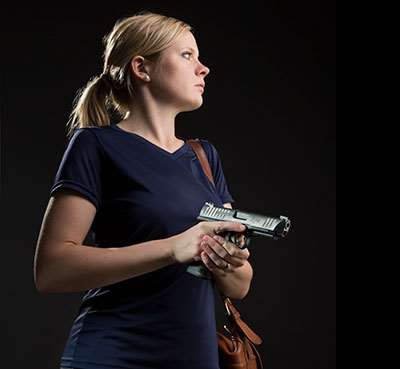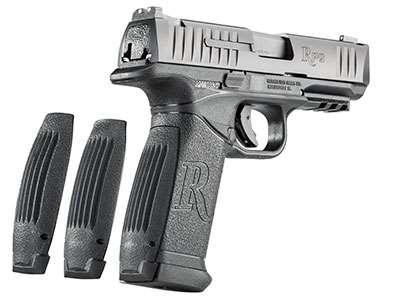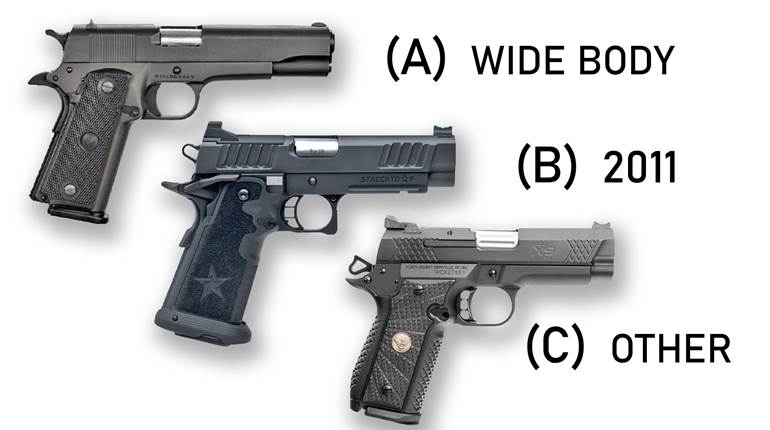

If you have followed the twists and turns of service-size, semi-automatic pistol development in recent years, you’ve doubtless noted that the more models offered, the more they seem to be alike. A certain style of gun has emerged. Today’s service pistols offer simplified operation, standard magazine capacities starting with at least 15 rounds of 9 mm Luger, lightweight polymer receivers and far better sights than we have ever had before. In keeping with its status as America’s senior gunmaker, Remington Arms offers two such guns for those who go armed in their own defense or in the protection of others.
Called the RP9 and RP45, these pistols strive to be competitive with the other service-size pistols on dealers’ shelves, but there is no reference to an RP40, which is certainly consistent with the decreasing popularity of the .40 S&W. The RP9 arrived in 2017, with the finished version of the RP45 following mid last year. Interestingly, both pistols are essentially the same in dimension and contour. There are no doubt manufacturing advantages to this, but holster compatibility is one that end users will appreciate. Both chamberings use the same holster and, even better, both use the same magazine pouches.

The basic RP is a recoil-operated, striker-fired semi-automatic pistol with a steel slide and a polymer receiver. This is no hideout—the RP is a big, hefty gun that boxes 7.91"x5.56"x1.27" with a 4.50" barrel. Capacity, by means of a steel, double-column magazine, crowds the top of the chart. In .45, the magazine holds 15 rounds, but the 9 mm tops that with 18.
Since Dieudonne Saivé designed a double-stack magazine for the High Power pistol, other makers have been using the same basic shape. In truth, the cartridge columns within the magazine are not so much stacked as they are staggered. The magazine’s body taper has to funnel the columns of cartridges up into a single-width opening at its mouth so that rounds are presented singly to the barrel’s feed ramp. The Saivé trick was an unusual diamond-shaped recess stamped into both sides of the magazine tube that ensures its rigidity and guides the cartridges. Interestingly, the same basic RP magazine body, or tube, is used for both chamberings—although those for the 9 mm Luger differ from the .45’s in the dimension and shape of the feed lips, as well as in the presence of vertical ribs not found on the .45. Impressed into the sheet metal on both sides, the ribs reduce the magazine’s interior width to a point appropriate to the smaller cartridge’s body diameter. Don’t be confused—the magazines are not interchangeable. Using the same tube is a manufacturing expedient.

The magazines would actually protrude past the bottom of the gun’s magazine well if not for an appropriately contoured floorplate, or slam pad, made of polymer. Extending below the sides and front of the magazine well edges, the backstrap of the pistol helps in speed reloads. When reloading, this creates a prominent surface on which a tactical shooter indexes his magazine before thrusting it home. Also note that there are two other sizes of backstrap inserts that may be swapped out to fit the butt of the pistol to the hand of the individual shooter. All of the contact surfaces on the butt are rounded for shooter comfort and finished with an even, grained surface. The mold also delivers receiver shells with the big “R” for Remington on both sides.
The pistol’s operational controls are on the receiver. Both the 9 mm and .45, while fundamentally set up for right-handed users, can also accommodate lefties in the sense that the magazine catch is reversible and the slide lock is bilateral. When the time comes for maintenance, the shooter can quickly remove the pistol’s slide by unloading the gun, pressing the trigger, turning the left-side takedown lever 90 degrees downward and pulling the barrel and slide forward off the receiver. Note that the frame is polymer, with sheet metal parts for the pistol’s mechanism and even for the receiver rails that connect the upper and lower assemblies. The barrel and slide are machined from steel, and the slide’s lines both complement those of the frame and seamlessly incorporate functional features such as the cocking serrations.
The RP9 and RP45 are recoil-operated guns of the John Browning-designed tilting-barrel style. Upon recoil, the barrel, positively locked to the slide, moves rearward. After a short travel, the barrel encounters a cam surface in the receiver that unlocks it downward from the slide, camming the square-shaped rear end of the barrel downward and out of engagement with the ejection port. Contact surfaces are massive, and it is clear the gun was designed for rough service.

Even the mandatory accessory rail on the dustcover is full-length and solid. The new Remington pistol’s slide is a hefty chunk of steel, with a flat top surface and slightly curved sides. On each side, there is a panel of eight wide cocking serrations at the rear of the slide, supplemented by three more at the front. To facilitate re-holstering, Remington beveled the lower front corners of the slide; the style is modern and utilitarian.
The essence of any modern pistol is the trigger system. The RP-series pistols are striker-fired, with neither an interior or exterior hammer. Instead, there’s an in-line striker that is cocked when the slide cycles. In the test samples, trigger pressures of 5 lbs., 4 ozs. for the RP9 and 5 lbs., 7 ozs. for RP45 released the strikers to fire. Safeties, in the form of an internal drop safety, disconnector and articulated trigger safety, are all passive. This means that taking up the pistol in a firing grasp and placing your finger on the trigger readies the gun for firing—no further conscious effort is needed.
My subjective impression of these pistols is pretty positive. They are big and on the heavy side, but they performed well with only a few failures to chamber early in testing. It is possible that these new Remingtons mimic the performance of several other modern polymer and steel service guns in that they benefit strongly from a few hundred rounds of break-in.
The RP-series Remingtons seem to recoil a bit more noticeably than many of their contemporaries. I think I can offer a bit of insight as to why. The pistol’s weight—in either chambering—is quoted as 26 ozs. in the provided specifications. It’s actually closer to 29 ozs. according to my office scale. This is not far from the norm. It is the weight of an RP pistol with an empty magazine. The slide assembly alone—including the barrel, recoil spring and guide—weighs just over 18 ozs., or more than twice the weight of the frame. That disparity becomes readily apparent as the gun is fired and the magazine becomes empty. Why? Because the weight of a full payload of .45 ACP cartridges is more than 11 ozs., and it’s more than 7 ozs. for the 9 mm Luger.
So, the more the gun is fired, and the lighter it gets, the more pronounced its recoil becomes. I noticed this when I did the accuracy portion of the exercise, shooting from benched sandbags. These observations should not be construed as criticism of the Remingtons, as all semi-automatic pistols have the same characteristic. Actually, it is true of all repeating small arms. In the case of the Remington RP series, it is just a little more noticeable because of the weight disparity between the receiver and the recoiling slide assembly.
At the range, I did some informal plinking with mixed loads before going to the standard accuracy evaluation with five consecutive, five-shot groups. With three different types of good ammunition in each chambering, the groups ran between 2" to 3"; this is acceptable for a service pistol. The triggers were full of bumps and catches—hard to shoot. If anything stands out in this part of the shoot, it would have to be the unusual consistency in the group size. These are hand-held groups, and that means no consistent Ransom Rest for aiming and manual trigger manipulation.

On balance, the RP9 and RP45 would seem to be soundly built service pistols that would serve a peace officer or armed citizen well. They would benefit greatly from a better trigger system. I doubt that these rather large pistols will see much service as concealed carry guns, but they would do well as home defense arms. And finally, I have to mention the salient feature of the RP series from Remington. At the time this was written, the retail price tag for either the 9 mm Luger or .45 ACP was $418. And yes, that is a pretty sensible price for a new model—made even more so by the far lower at-the-counter prices.





































